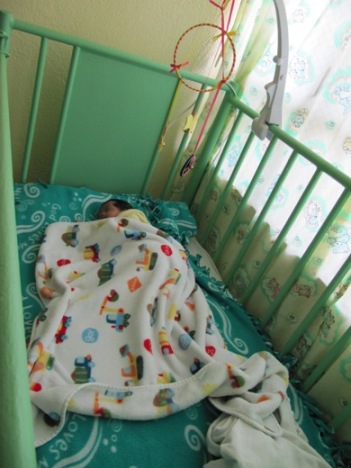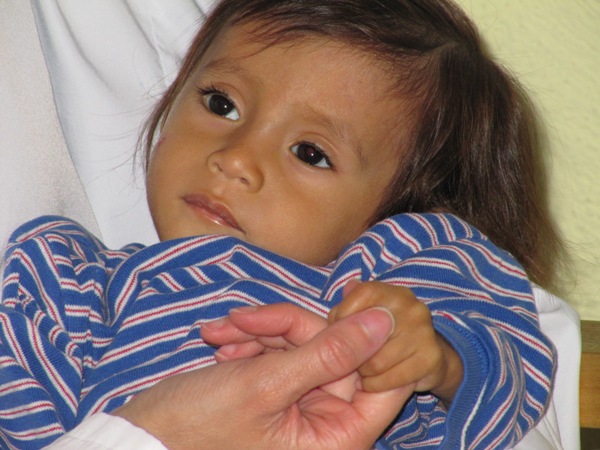By Maria Russo
Alberto’s bones were like flimsy pieces of cartilage floating in a soft, thin layer of skin and fat. I could feel a tiny set of ribs rise and recede each time I lifted, rocked and held him, fearing that any quick movement would hurt his fragile body. But the cuddling didn’t hurt, nor did the bursts of giggles from being tickled on his toes; in fact, Alberto was having a blissful time as we played together.
At first glance, the rooms on the treatment floor of Casa Jackson, a center for malnourished infants in Antigua, Guatemala, seemed to be filled with despair. The sight of listless babies lying in their cribs, too weak to cry or fuss, was utterly upsetting and almost too much to bear. But after a short walk through the halls and into the play area, a picture of hope began to form.
Casa Jackson is one of several programs organized under GOD’S CHILD Project, an international nonprofit organization founded in 1991 by human rights activist Patrick Atkinson. The organization, which also operates in El Salvador, Malawi, India and the United States, seeks to break the chains of poverty through education and formation.
The GOD´S CHILD Project in Guatemala, known as La Asociación Nuestros Ahijados (literal translation: Our Godchildren), is comprised of Casa Jackson and 12 other programs including a school for children ages five to 15, a medical and dental clinic, the Institute for Trafficked, Exploited & Missing Persons (ITEMP), a technical training center and a homeless shelter–all of which rely on volunteers to operate.
After learning about the organization through a friend, I planned a trip to Guatemala with the intention of being a “voluntourist” for a couple of days. Having only one week in the country, and wanting to allocate the time between sight-seeing and volunteering, La Asociación Nuestros Ahijados was the perfect fit due to the flexible nature of the program (you can volunteer for two days, or sign-up for two years), and because they don’t charge a fee to participate in the projects, unlike most other volunteer programs.
On the morning of my second day in Antigua, I arrived at La Asociación Nuestros Ahijados, located on the outskirts of the San Felipe slums, prepared for a day of volunteering at Casa Jackson. I watched in delight as children with freshly combed hair and crisp blue uniforms poured in through the entrance gates and headed down a sloping, paved hill towards The Dreamer Center School. Many little ones walked arm-in-arm, with peers and siblings, laughing, skipping, and stopping to pet the resident dogs before heading to class. There was a serene aura that inundated the cheerful grounds, purposely separated from the surrounding dilapidated areas by imposing gates.
Most of the buildings, which house La Asociación Nuestros Ahijados programs, were erected on the remains of Antigua´s former garbage dump. The fertile land rendered soil perfect for growing hundreds of species of vibrant flora that now coat the center’s expansive grounds. It was through Atkinson’s dream of creating an oasis for those escaping hardship, that he designed the magnificent complex, which, similar to its own roots, now provides many community members with a second chance at life.
Once most of the children had funneled in to begin a rigorous day of learning, I was welcomed by the center’s director, Luke Armstrong, to join a group tour he was leading. As we ambled into a dusky conference room, Luke began to talk about the organization’s lifeline known as the Sponsorship program.
“More than 800 children receive medical, dental, psychological and legal aid services thanks to approximately 1,400 ‘Godparents’ who assist in providing them with these vital benefits. If they are old enough to attend school, the children are also encouraged by their sponsors to enroll in the scholarship program, a financial incentive system based on academic achievement,” Luke noted as he began to lead us through the center’s open-air corridors.
After exploring the clinics, offices and gleaming classrooms, the tour concluded just down the road from The Dreamer Center complex at Casa Jackson. Luke handed the tour over to Andrea, the center’s volunteer coordinator, who welcomed us with a brief introduction to the program’s operations.
“In Guatemala, 50 percent of children under the age of five are malnourished. Without adequate treatment, many of these children incur serious health issues, which become chronic, or even fatal. That’s where we come in. The infants come to Casa Jackson for medical care until they are healthy enough to return to their families,” Andrea said as she led us to the locker room.

After donning the scrubs provided and wrapping masks around our faces, we headed upstairs to meet the babies. Andrea led us into a small room flanked with honeydew-colored cribs cradling sleeping infants. Medical charts hung above the tiny beds exposing the strikingly low weight of many of the infants.
“Maria, it would be great if you and Anthony could learn the ropes from Sarah from here on,” Andrea said to me and my husband. I thanked her for the partial tour and listened as Sarah gave us the lowdown on the day’s jobs.
It was fairly simple: change diapers, assist with feedings, and provide as much attention to the babies as possible. “They really just need some affection,” Sarah said as she lifted a little boy named Rene from his crib.
I headed out to the play area and smiled at a row of children lying on a gymnasium mat. They were captivated by one of the male volunteers who was singing and dancing in such a ludicrous manner that even I let out a soft chuckle. I then noticed a little boy sitting still and quiet in a bouncy chair.
“What’s his name?” I said calling out to one of the nurses. “Alberto,” the nurse called back. I lifted the little guy from his whimsical chair of twirling plastic shapes, and almost instantly we became buddies.
Alberto, like all the other children at Casa Jackson, will stay only until his health improves and once strong enough will return to his family. While the children reside at the center, social workers associated with the program educate family members, about proper nutrition for infants, young children and expecting mothers.
Having allotted only two days of my week-long trip to volunteering, I yearned for more time at Casa Jackson. Helping with menial tasks such as changing dirty diapers and cleaning a runny nose, were no bother to me as I reveled in the time spent with each baby. Their weak smiles and insatiable curiosity for the new strangers in over-sized white coats made every moment a precious gift.
Later that day, I realized I had signed-up for the program with the intention of helping someone in a small way, and just the opposite happened — the tiny infant I grew to adore over the few precious hours I spent at the center, reshaped my entire perspective on the human spirit. And I began to believe that when there is hope, life can rise from just about anything.
READ MORE STORIES IN GOOD




